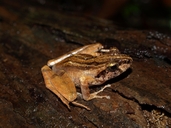|
Description
M 34-37 mm, F 32-39 mm. Dorsally less granular than G. asper and G. spinifer. Inner and outer dorsolateral ridges usually present. Small heel spines. Two often indistinct and longitudinal interocular tubercles. Colouration very variable. Males with blackish paired subgular vocal sacs (Glaw and Vences 2007). Distribution and Habitat
Country distribution from AmphibiaWeb's database: Madagascar
Manongarivo, Montagne d’Ambre (Glaw and Vences 2007). This species has been observed at an elevational range between 500-1200 m asl in pristine rainforest only (Raxworthy and Vences 2008).Life History, Abundance, Activity, and Special Behaviors
Habits: Males call at night from bushes, 0.5-1.5 m above the ground, in or near rainforest, usually close to streams. Generalized free swimming tadpoles in small streams (Glaw and Vences 2007).
Calls: A slow series of about 15 unharmonious notes (Glaw and Vences 2007).
Trends and Threats
This species is listed as vulnerable because its Extent of Occurrence is less than 20,000 km2, its distribution is severely fragmented, and there is continuing decline in the extent and quality of its forest habitat in northern Madagascar. It has a very fragmented distribution but occurs within several protected areas: the Parc National de Montagne d'Ambre, the Réserve Naturelle Intégrale du Tsaratanana, and the Réserve Spéciale de Manongarivo. A major threat is habitat loss, due to expanding subsistence agriculture, logging, charcoal manufacture, increased grazing, invasion and spread of eucalyptus, and expanding human settlement (Raxworthy and Vences 2008). Possible reasons for amphibian decline General habitat alteration and loss
Habitat modification from deforestation, or logging related activities
Intensified agriculture or grazing
Urbanization
Subtle changes to necessary specialized habitat
Habitat fragmentation
Comments
Taken with permission from Glaw and Vences (2007).
References
Glaw, F., and Vences, M. (2007). Field Guide to the Amphibians and Reptiles of Madagascar. Third Edition. Vences and Glaw Verlag, Köln.
Raxworthy, C. and Vences, M. (2008). Gephyromantis ambohitra. In: IUCN 2008. 2008 IUCN Red List of Threatened Species. www.iucnredlist.org. Downloaded on 20 March 2009.
Originally submitted by: Miguel Vences and Frank Glaw (first posted 2009-03-20)
Edited by: Catherine Aguilar (2009-04-07)Species Account Citation: AmphibiaWeb 2009 Gephyromantis ambohitra <https://amphibiaweb.org/species/5934> University of California, Berkeley, CA, USA. Accessed Mar 31, 2025.
Feedback or comments about this page.
Citation: AmphibiaWeb. 2025. <https://amphibiaweb.org> University of California, Berkeley, CA, USA. Accessed 31 Mar 2025.
AmphibiaWeb's policy on data use.
| 